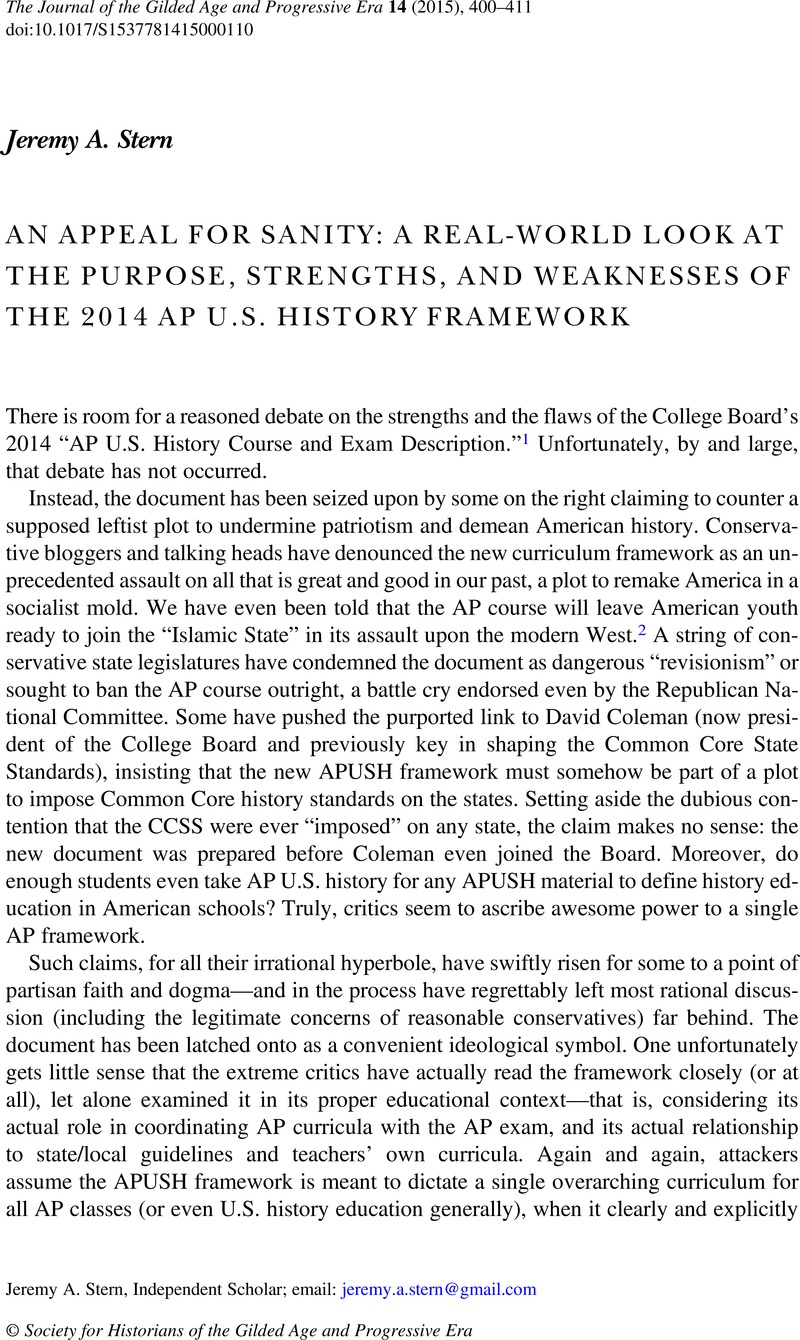No CrossRef data available.
Article contents
AN APPEAL FOR SANITY: A REAL-WORLD LOOK AT THE PURPOSE, STRENGTHS, AND WEAKNESSES OF THE 2014 AP U.S. HISTORY FRAMEWORK
Published online by Cambridge University Press: 22 July 2015
Abstract

- Type
- Teaching Forum: Pedagogy and Controversy in The New Advanced Placement U.S. History Framework
- Information
- Copyright
- Copyright © Society for Historians of the Gilded Age and Progressive Era 2015
References
NOTES
1 “AP United States History Course and Exam Description Including the Curriculum Framework,” media.collegeboard.com/digitalServices/pdf/ap/ap-us-history-course-and-exam-description.pdf.
2 Valerie Strauss, “Ben Carson: New AP U.S. History Course Will Make Kids Want to ‘Sign up for ISIS,’” Washington Post, September 29, 2014, http://www.washingtonpost.com/blogs/answer-sheet/wp/2014/09/29/ben-carson-new-ap-u-s-history-course-will-make-kids-want-to-sign-up-for-isis/.
3 See Jeremy A. Stern and Sheldon M. Stern, The State of State U.S. History Standards 2011 (Washington, DC: Thomas B. Fordham Institute, 2011), edex.s3-us-west-2.amazonaws.com/publication/pdfs/SOSS_History_FINAL_7.pdf. The “Introduction and National Findings,” 13–16, discusses the dangers of politicization from both left and right, with a particular focus on Texas; the Texas review appears on 141–43.
4 Jeremy A. Stern, “The New AP US History Test Guide: Standards-lite, Thematic guide, or Not Quite Either?,” May 15, 2014, edexcellence.net/articles/new-ap-us-history-test-guide-standards-lite-thematic-guide-or-not-quite-either.
5 I should add that I have my doubts about the usefulness of the overarching and transhistorical “learning objectives” laid out in Charap's Table 2—a point I made already last year (Stern, “The New AP US History Test Guide”); The importance of the document, to my mind, lies chiefly in the specifics of the “concept outline”—the real meat of the APUSH guide, and the part it is most important to get right for the benefit of teachers and students. AP teachers themselves should be the judges of the “learning objectives” and their usefulness.
6 See, for example, Rick Hess, “10 Thoughts on the New AP U.S. History Framework,” Sept. 8, 2014, http://blogs.edweek.org/edweek/rick_hess_straight_up/2014/09/10_thoughts_on_the_new_ap_us_history_framework.html; Hess spoke “at length” with a College Board official in order to understand the Board's perspective, and took much note of the Board's viewpoint in his own remarks.
7 Johnston, Robert D., “Long Live Teddy/Death to Woodrow: The Polarized Politics of the Progressive Era in the 2012 Election,” Journal of the Gilded Age and Progressive Era 13(July 2014): 411–43CrossRefGoogle Scholar.
8 John M. Murrin, “Anglicizing an American Colony: The Transformation of Provincial Massachusetts” (PhD diss., Yale University, 1966).
9 Thus, political leaders such as Samuel Adams, who promoted crowd actions like the original 1773 tea destruction, staunchly opposed later violent risings such as Shays’ Rebellion and the Whiskey Rebellion: with a republican system now in place and government thus answerable to the people, extralegal measures were no longer seen as justified.




